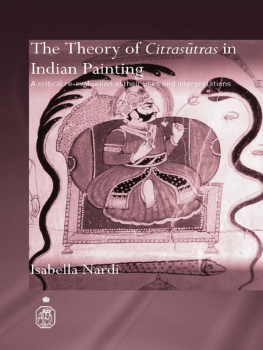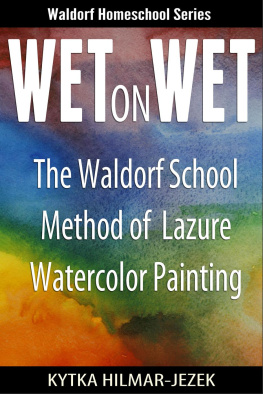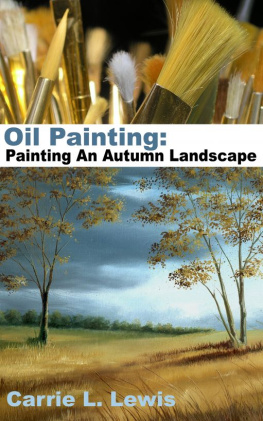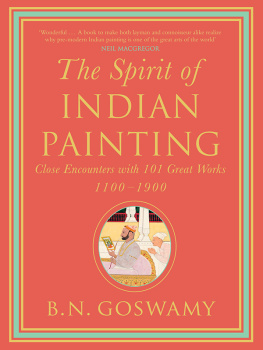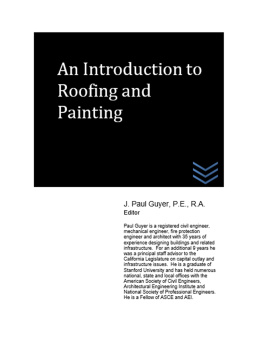The study of technical treatises in Indian art has increasingly attracted much interest. This work puts forward a critical re-examination of the key Indian concepts of painting described in the Sanskrit treatises, called citrastras. In an in-depth and systematic analysis of the texts on the theory of Indian painting, it critically examines the different ways in which the texts have been interpreted and used in the study of Indian painting and suggests a new approach to reading and understanding their concepts. Contrary to previous publications on the subject, it is argued that the intended use of such texts as a standard of critique largely failed due to a fundamental misconceptualization of the significance of text for Indian painters. Scholars have hitherto remained blinded by the unquestioned belief that texts are to be considered prescriptive compilations or guides to be literally followed. This work offers an original, fresh approach to research in this field by drawing on the experiences of painters, who are considered as a valid source of knowledge for our understanding of the citrastras, and provides a new conceptual framework for understanding the interlinkages between textual sources and the practice of Indian painting.
ROYAL ASIATIC SOCIETY BOOKS
The Royal Asiatic Society was founded in 1823 for the investigation of subjects connected with, and for the encouragement of science, literature and the arts in relation to, Asia. Informed by these goals, the policy of the Societys Editorial Board is to make available in appropriate formats the results of original research in the humanities and social sciences having to do with Asia, defined in the broadest geographical and cultural sense and up to the present day.
THE MAN IN THE PANTHERS SKIN
Shota Rustaveli
Translated from the Georgian by
M.S. Wardrop
New Foreword by Donald Rayfield
WOMEN, RELIGION AND CULTURE IN IRAN
Edited by Sarah Ansari andVanessa Martin
SOCIETY, POLITICS AND ECONOMICS IN MAZANDARAN, IRAN
18481914
Mohammad Ali Kazembeyki
THE ZEN ARTS
Rupert Cox
STUDIES IN TURKIC AND MONGOLIC LINGUISTICS
Gerard Clauson
New Introduction by
C. Edmund Bosworth
THE HISTORY OF THE MOHAMMEDAN DYNASTIES IN SPAIN
Ahmed ibn Mohammedal-Makkari
Translated from the Arabic by
Pascual de Gayangos
New Introduction by
Michael Brett
THE COURTS OF PRE-COLONIAL SOUTH INDIA
Jennifer Howes
PERSIAN LITERATURE: A BIO-BIBLIOGRAPHICAL SURVEY
Volume V: poetry of the pre-Mongol period
Franois de Blois
MUSLIMS IN INDIA SINCE
1947
Islamic perspectives on inter-faith relations
Yoginder Sikand
THE ORIGINS OF HIMALAYAN STUDIES
Brian Houghton Hodgson in Nepal and Darjeeling
18201858
Edited by David M. Waterhouse
GRIEVANCE ADMINISTRATION (IKAYET) IN AN OTTOMAN PROVINCE
The Kaymakam of Rumelias Record Book of Complaints of
17811783
Michael Ursinus
THE CHEITHAROL KUMPAPA: THE COURT CHRONICLE OF THE KINGS OF MANIPUR
Original text, translation and notes
vol. 1. 331763 CE
Saroj Nalini Arambam Parratt
ANGLO-IRANIAN RELATIONS SINCE 1800
Edited by Vanessa Martin
THE BRITISH OCCUPATION OF INDONESIA 19451946
Britain, the Netherlands and the Indonesian Revolution
Richard McMillan
THE POLITICS OF SELF-EXPRESSION
The Urdu middle-class milieu in mid-twentieth-century India and Pakistan
Markus Daechsel
THE THEORY OF CITRASTRAS IN INDIAN PAINTING
A critical re-evaluation of their uses and interpretations
Isabella Nardi
First published 2006
by Routledge
2 Park Square, Milton Park, Abingdon, Oxon OX14 4RN
Simultaneously published in the USA and Canada
by Routledge
270 Madison Ave, New York, NY 10016
Routledge is an imprint of the Taylor & Francis Group,an informa business
This edition published in the Taylor & Francis e-Library, 2007.
To purchase your own copy of this or any of Taylor & Francis or Routledges collection of thousands of eBooks please go to www.eBookstore.tandf.co.uk.
2006 Isabella Nardi
All rights reserved. No part of this book may be reprinted or reproduced or utilized in any form or by any electronic, mechanical, or other means, now known or hereafter invented, including photocopying and recording, or in any information storage or retrieval system, without permission in writing from the publishers.
British Library Cataloguing in Publication Data
A catalogue record for this book is available from the British Library
Library of Congress Cataloging in Publication Data
Nardi, Isabella, 1970
The theory of Citrasutras in Indian painting: a critical re-evaluation of their uses and interpretations/Isabella Nardi.
p. cm.
Includes bibliographical references and index.
1. Painting, IndicTechnique. 2. Painting, HinduTechnique. 3. Puranas. Visnudharmottarapurana. Citrasutra. I. Title.
ND1001.N38 2006
759.954dc22 2005033451
ISBN 0-203-97010-1 Master e-book ISBN
ISBN10: 0-415-39195-4 (hbk)
ISBN10: 0-203-97010-1 (ebk)
ISBN13: 978-0-415-39195-5 (hbk)
ISBN13: 978-0-203-97010-2 (ebk)
FIGURES
TABLES
ACKNOWLEDGEMENTS
This thesis would not have been possible without the kind assistance and support of various people. I would like to acknowledge, first of all, the artists and academics who were able to devote some of their time to discussing the theory and practice of Indian painting and patiently answering all my questions. Many thanks are due to Vinod Bhardvaj and Jatin Das in New Delhi, Lalit Sharma, Shail Choyal and his family, Dr Vishnu Mali, Chiranjeev Lal Sharma, Ghanshyam Kanyalalji Sharma, Hemant Chitrakar, Sukhlal Jangid and Ramesh Chandr Jangid in Udaipur and Nathdvara, Kripal Singh Shekhavat, Ram Prasad Sharma and his family and Pramod Sharma in Jaipur, Gopal Joshi in Bhilvara, Ram Gopal Joshi in Chittor, Ramesh Mohanty, Sri Harihar Moharana, Binod Maharana and Sudarsan Mohapatra in Orissa and finally, Kalamani T. Venkatesaraja and R. Emberumal in Tanjore.
In London, I would like to give particular thanks to my supervisor Dr Giles Tillotson for his valuable suggestions, Dr Vibhuti Sachdev for sharing with me her ideas and knowledge of vastuvidya, Dr Renate Sohnen-Thieme for helping me to improve my knowledge of Sanskrit and Martin Menski for commenting on some of the drafts.
As for institutions, my thanks go to the helpful staff at the SOAS Library, especially Marina Chellini, the British Library and the National Art Library in London, the Craft Museum in New Delhi and the South Zone Cultural Centre in Tanjore. The support given by the grants from SOAS and the Central Research Fund of the University of London are duly acknowledged.

